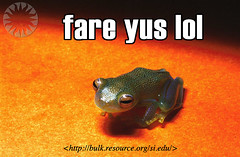Jenny points out the UIUC library search which is a widget that can be put on any user’s facebook page so they can search the library catalog right from Facebook.
Facebook recently opened up their site to other applications and there has been a huge explosion in what people are sharing on their profile pages. From my own subjective perspective, it seems like these applications are getting more people to Facebook and keeping them there, doing stuff. In my 2.0 talks I have often talked about how libraries could create “presence” using social tools and I’ve pointed to Facebook groups like Awesome Resources which is a group of 30+ librarians doing what librarians do best: sharing resources and helping each other find things.
When I went to Ann Arbor this week, I connected with Ed “Superpatron” Vielmetti on Facebook and it’s one of the fastest and best ways to get ahold of a small subset of my friends. When I was at the Berkman Center event last week listening to them talk about Digital Natives (versus tired old “digital immigrants” like myself) a professor mentioned that they did a show of hands survey of their incoming class to Harvard this year and asked who had a Facebook page. The answer wasn’t “most of them” but every single one of them. Granted Harvard skews in some ways towards the clueful and plugged in, but what an opportunity, knowing the one place that all of your students go online. I’m not totally sure if we know what to there once we get there, and I share the same privacy concerns as others about how much information we’re aggregating and personally identifying there, but I also feel that the UIUC search box is a little breakthrough application, sort of the way LibX was for Firefox. Exciting times, no?
